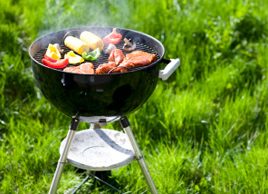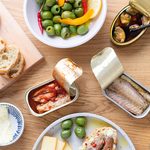Could grilling your food be dangerous?
Studies have shown that cooking your food at high temperatures may be bad for your health. Is grilling your food dangerous? Read on to find out

Source: Web exclusive, June 2010
Who doesn’t love the taste of roasted potatoes paired with a juicy grilled burger and cheesy garlic bread browned to perfection under the broiler? Cooking food at high temperatures may be responsible for many mouth-watering culinary delights’but there’s never been more reason to turn down the heat in your kitchen.
High-heat cooking methods like grilling, frying, roasting or broiling trigger a chemical reaction between the sugar, fat and protein in your food‘a reaction that creates nasty toxins called advanced glycation end products, or AGEs. When we eat these toxins, they stay in our system and through a process of oxidization cause inflammation throughout the body. Too much of this inflammation’that is, too many AGEs’can potentially lead to health problems, such as diabetes, heart disease and kidney disease. AGEs have also been linked to skin damage, depriving your skin of moisture and making you look older.
The benefits of low-heat cooking
In a recent study involving more than 350 healthy people, as well as those with kidney disease, researchers from Mount Sinai School of Medicine in New York found that cutting back on foods cooked at high temperatures’including processed foods, many of which are manufactured at high heat’can help prevent disease, as well as lead to weight loss and potentially increase lifespan.
“AGEs are palate pleasing,” says Dr. Helen Vlassara, lead researcher for the Mount Sinai study. “And the better food tastes the more addicted we get to it.” Case in point, she says, pizza and bacon are the top two AGEs-containing foods.
Okay, so maybe you’re not going to completely swear off Sunday morning bacon and eggs, or that once-in-a-while Friday night pizza when you’re too tired to care about chemistry and scientific acronyms. But there are simple ways of introducing low-temperature cooking into your diet.
How to cook at a lower temperature
“The most common low-heat cooking methods are stewing and braising,” says chef Christine Walker, coordinator and professor at George Brown Culinary School in Toronto. Both are similar in that they use liquid’either stock, water, canned tomatoes, wine, or any combination’to cook food. The difference, explains Walker, is the amount of liquid used. Stews use about three to four cups of water for a standard meal, as opposed to one or two cups for braising.
The drawback for modern cooks? These methods take time’several hours in some cases, depending on the size of the meal and the cut of your meat. “Most of us are in a hurry these days,” says Walker, explaining why many individuals no longer cook this way, despite the wonderfully flavourful dishes it yields. “We just want fast and easy.”
Low-heat cooking tips for time-crunched chefs
If you think you don’t have the time to cook meals with less heat, consider a slow cooker. Add your ingredients to the pot in the morning, or the night before, and these handy countertop appliances will cook your food all day long, whether you’re at home or at the office.
And there’s another big tip to help cut down on the time and perceived complexity of low-heat cooking, though you won’t hear it from the mouths of most chefs. In reality, you don’t really have to brown your meat/chicken/pork before you stew or braise it like the culinary pros insist. Even Jamie Oliver in his Jamie’s Dinner cookbook categorically states he no longer bothers browning his meat for any stew.
More ways to cut AGEs out of your diet
It’s not just the low heat that makes stewing and braising good cooking methods, it’s also the humidity factor, which counteracts the formation of AGEs. This is why poaching (submerging your food in any low-temperature liquid whereby the bubbles only occasionally break the surface) is an ideal way to prepare meals; chicken breasts, for one, do especially well when poached. And despite the high temperatures involved in steaming and boiling, the high humidity also makes them excellent cooking choices. For example, says Vlassara, boiling a potato creates just 10 units of AGEs, while roasting it generates a whopping 1,000 units.
If you can’t completely abandon high-heat cooking, there are a few tips for keeping the AGEs count down. Acids, like lemon and vinegar, deter AGEs from developing, so consider using this type of marinade before you subject your food to high heat. Also, avoid using bottled sauces that are often high in sugar and fat. These are the key components in the chain reaction that produces AGEs’the more sugar and fat, the more AGEs you’ll consume.
Will one more reason to cut down on sugar and fat convince Canadians to alter their eating ways? Vlassara and her team of scientists have found that the standard Western diet contains at least three times more AGEs than is considered safe. But instead of diminshing, that rate only seems to be growing stronger. “It’s the puzzle of the century,” she says.
Related:
‘ A marinade that will make your meat healthier
‘ 5 habits you thought were healthy, but aren’t
‘ 20 healthy grilling recipes men will love
Don’t miss out! Sign up for our free weekly newsletters and get nutritious recipes, healthy weight-loss tips, easy ways to stay in shape and all the health news you need, delivered straight to your inbox.




